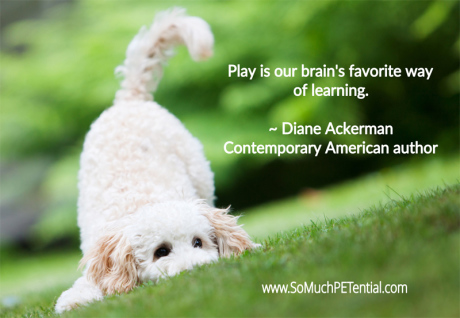When you think about pet training and behavior management, do you also think about playing?
Think about it for a minute. Think about how much more engaged you are in an activity or a conversation (and tuning out the outside distractions) when you are laughing and being challenged.
Have you watched your dog or your parrot or cat when he is really focused on figuring something out? I have seen dogs with reputations for jumping on their owners at kitchen counters, not even taking the time to look up when they are busy trying to figure out how to make food come out of a toy. And guess what else I saw in those dogs…tails wagging and wiggly bodies. Those are dogs that are having fun.
I have seen play described as ‘the vehicle by which children learn to relate to others, to solve problems and to regulate  their emotions.’ Those are words to give you thought when it comes to effective teaching, learning and quality of life.
their emotions.’ Those are words to give you thought when it comes to effective teaching, learning and quality of life.
Martin Seligman, past president of the American Psychological Association and author of Authentic Happiness, goes further and says play is one of three pillars of mental health – the other two being love and work.
Of course he is talking about human beings but non-humans have mental and physical needs as well.
There is such a long list of reasons why play is important to our pets. Just some of them include: release of energy, mastering new concepts, conflict resolution, gross and fine motor skill experiences, self control development and confidence development.
So, let’s bring this back to training. What are the benefits to including play as a reinforcing consequence for doing another behavior? Well, for one, it adds variety to the lesson if you keep your dog guessing as to whether sitting will get him a treat, a great chase, or an opportunity to tug. Games can be taken on the road. You may not have food available when you are out with your dog and he does just what you want him to do, but you sure can run the other direction or pick up a stick and throw it. And, with all these awesome experiences, the side benefit is that your dog will come to associate you with those awesome experiences and that makes for even more awesome relationships.
Here are a few other ideas for incorporating play into training.
Sunday night I had a couple minutes and thought I’d work with our Sam on targeting and stationing (standing with his front two feet on a round platform). He had already eaten, and so was not at his optimal motivation level for food. Still, I had a student who was totally focused – even when I was using lower value food. How? After I clicked, instead of delivering his treat to his mouth I tossed it…and he ran to get it. Then he’d run back to the platform and I’d click and toss a treat in another direction. The speed he was moving was incredible and he had no notice that in the other room, my mom was cleaning up from a chicken dinner. The game of it (and the rapid rate of reinforcement) was what kept his focus.
I also love to create games and then incorporate behavior skills that I have taught him (and others) to strengthen those skills. It is the Premack Principle at its best! (To learn more about the Premack Principle, please click here.) To tug with a toy, you can teach your dog that play begins when you initiate it (maybe you ask your dog to sit or do another behavior before giving the cue to tug); and that it stops when you give the cue. Embedded in a hide and go seek, you can practice the behaviors of sit or down/stay, release cue, coming when called, sitting at your feet and even waiting as you toss a treat on the ground before being release to get it.
Clicker training and shaping and play too when you think about it. Below are a few video clips to give you some ideas.
There are so many ways to incorporate play into your lesson plan. I’d love to hear what you do.
Remember, always have fun!






